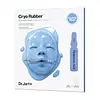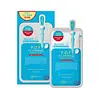What's inside
What's inside
 Key Ingredients
Key Ingredients

 Benefits
Benefits

 Concerns
Concerns

 Ingredients Side-by-side
Ingredients Side-by-side

Water
Skin ConditioningDipropylene Glycol
HumectantGlycerin
HumectantCaprylic/Capric Triglyceride
MaskingNiacinamide
Smoothing1,2-Hexanediol
Skin ConditioningButylene Glycol
HumectantPEG-240/Hdi Copolymer Bis-Decyltetradeceth-20 Ether
StabilisingGlyceryl Stearate
EmollientPEG-100 Stearate
Sorbitan Sesquioleate
EmulsifyingGlycereth-26
HumectantDimethicone
EmollientCetearyl Alcohol
EmollientTrehalose
HumectantMangifera Indica Seed Butter
Skin ConditioningMacadamia Ternifolia Seed Oil
EmollientSodium Hyaluronate
HumectantGlyceryl Acrylate/Acrylic Acid Copolymer
HumectantEthylhexylglycerin
Skin ConditioningDisodium EDTA
Betaine
HumectantAllantoin
Skin ConditioningMelia Azadirachta Leaf Extract
Skin ConditioningMelia Azadirachta Flower Extract
Skin ConditioningCoccinia Indica Fruit Extract
Skin ConditioningTocopherol
AntioxidantPotassium Laurate
EmulsifyingSolanum Melongena Fruit Extract
Skin ConditioningAloe Barbadensis Flower Extract
EmollientSimmondsia Chinensis Seed Oil
EmollientOcimum Sanctum Leaf Extract
Skin ConditioningCurcuma Longa Root Extract
MaskingCorallina Officinalis Extract
Skin ConditioningUndaria Pinnatifida Extract
Skin ConditioningMusa Sapientum Fruit Extract
Skin ConditioningCynara Scolymus Leaf Extract
Skin ConditioningBrassica Oleracea Capitata Leaf Extract
Skin ConditioningAsparagus Officinalis Extract
Skin ConditioningAllium Cepa Bulb Extract
Skin ConditioningMethylpropanediol
SolventChondrus Crispus Extract
Skin ConditioningXanthan Gum
EmulsifyingCeratonia Siliqua Gum
EmollientPotassium Chloride
Hydroxyacetophenone
AntioxidantSucrose
HumectantPanthenol
Skin ConditioningPolyglyceryl-10 Laurate
Skin ConditioningAlgin
MaskingTitanium Dioxide
Cosmetic ColorantCaprylyl Glycol
EmollientCalcium Chloride
AstringentDipotassium Glycyrrhizate
HumectantSodium Citrate
BufferingCitric Acid
BufferingXylitylglucoside
HumectantAnhydroxylitol
HumectantXylitol
HumectantLaminaria Japonica Extract
Skin ProtectingHydrogen Dimethicone
Glucose
HumectantKaolin
AbrasiveDiatomaceous Earth
AbrasiveWater, Dipropylene Glycol, Glycerin, Caprylic/Capric Triglyceride, Niacinamide, 1,2-Hexanediol, Butylene Glycol, PEG-240/Hdi Copolymer Bis-Decyltetradeceth-20 Ether, Glyceryl Stearate, PEG-100 Stearate, Sorbitan Sesquioleate, Glycereth-26, Dimethicone, Cetearyl Alcohol, Trehalose, Mangifera Indica Seed Butter, Macadamia Ternifolia Seed Oil, Sodium Hyaluronate, Glyceryl Acrylate/Acrylic Acid Copolymer, Ethylhexylglycerin, Disodium EDTA, Betaine, Allantoin, Melia Azadirachta Leaf Extract, Melia Azadirachta Flower Extract, Coccinia Indica Fruit Extract, Tocopherol, Potassium Laurate, Solanum Melongena Fruit Extract, Aloe Barbadensis Flower Extract, Simmondsia Chinensis Seed Oil, Ocimum Sanctum Leaf Extract, Curcuma Longa Root Extract, Corallina Officinalis Extract, Undaria Pinnatifida Extract, Musa Sapientum Fruit Extract, Cynara Scolymus Leaf Extract, Brassica Oleracea Capitata Leaf Extract, Asparagus Officinalis Extract, Allium Cepa Bulb Extract, Methylpropanediol, Chondrus Crispus Extract, Xanthan Gum, Ceratonia Siliqua Gum, Potassium Chloride, Hydroxyacetophenone, Sucrose, Panthenol, Polyglyceryl-10 Laurate, Algin, Titanium Dioxide, Caprylyl Glycol, Calcium Chloride, Dipotassium Glycyrrhizate, Sodium Citrate, Citric Acid, Xylitylglucoside, Anhydroxylitol, Xylitol, Laminaria Japonica Extract, Hydrogen Dimethicone, Glucose, Kaolin, Diatomaceous Earth
Water
Skin ConditioningGlycerin
HumectantPropanediol
Solvent1,2-Hexanediol
Skin ConditioningAlcohol
AntimicrobialSalix Alba Bark Extract
AstringentPortulaca Oleracea Extract
Skin ConditioningHouttuynia Cordata Extract
Skin ConditioningCentella Asiatica Extract
CleansingChamomilla Recutita Flower Extract
MaskingHydrolyzed Collagen
EmollientAloe Barbadensis Leaf Juice
Skin ConditioningBeta-Glucan
Skin ConditioningXanthan Gum
EmulsifyingButylene Glycol
HumectantBoswellia Serrata Resin Extract
SmoothingPanthenol
Skin ConditioningTrehalose
HumectantBetaine
HumectantCarbomer
Emulsion StabilisingAllantoin
Skin ConditioningPolysorbate 80
EmulsifyingArginine
MaskingAdenosine
Skin ConditioningDisodium EDTA
Dipotassium Glycyrrhizate
HumectantTocopheryl Acetate
AntioxidantSalicylic Acid
MaskingEthylhexylglycerin
Skin ConditioningParfum
MaskingWater, Glycerin, Propanediol, 1,2-Hexanediol, Alcohol, Salix Alba Bark Extract, Portulaca Oleracea Extract, Houttuynia Cordata Extract, Centella Asiatica Extract, Chamomilla Recutita Flower Extract, Hydrolyzed Collagen, Aloe Barbadensis Leaf Juice, Beta-Glucan, Xanthan Gum, Butylene Glycol, Boswellia Serrata Resin Extract, Panthenol, Trehalose, Betaine, Carbomer, Allantoin, Polysorbate 80, Arginine, Adenosine, Disodium EDTA, Dipotassium Glycyrrhizate, Tocopheryl Acetate, Salicylic Acid, Ethylhexylglycerin, Parfum
 Reviews
Reviews

Ingredients Explained
These ingredients are found in both products.
Ingredients higher up in an ingredient list are typically present in a larger amount.
1,2-Hexanediol is a synthetic liquid and another multi-functional powerhouse.
It is a:
- Humectant, drawing moisture into the skin
- Emollient, helping to soften skin
- Solvent, dispersing and stabilizing formulas
- Preservative booster, enhancing the antimicrobial activity of other preservatives
Allantoin is a soothing ingredient known for its protective and moisturizingg properties. Because of this, it is often added to products with strong active ingredients.
Studies show higher concentrations of this ingredient can promote wound healing.
Though it can be derived from the comfrey plant, allantoin is produced synthetically for cosmetic products to ensure purity.
Learn more about AllantoinBetaine is a common humectant (a substance that promotes retention of moisture). It's known to be gentle on the skin and can help balance hydration.
This ingredient is best for improving hydration and soothing irritated skin. Studies also show it helps even out skin tone.
Fun fact: Betaine is naturally created in the skin and body. The kind found within cosmetic products can be either plant-derived or synthetic.
Another name for betaine is trimethylglycine.
Learn more about BetaineButylene Glycol (or BG) is used within cosmetic products for a few different reasons:
Overall, Butylene Glycol is a safe and well-rounded ingredient that works well with other ingredients.
Though this ingredient works well with most skin types, some people with sensitive skin may experience a reaction such as allergic rashes, closed comedones, or itchiness.
Learn more about Butylene GlycolDipotassium Glycyrrhizate comes from licorice root.
Extracts of licorice have demonstrated to have antibacterial, anti‐inflammatory, antiviral, antioxidant properties.
One component, glabridin, has extra potent antioxidant and soothing properties. It has also been found to block pigmentation from UVB rays in guinea pigs.
Licorice Root also contains a flavonoid. Flavonoids are a natural substance from in plants. Flavonoids also have antioxidant properties.
Another component, glycyrrhizin, has been found to have anti-inflammatory and antimicrobial benefits. This may make licorice root extract effective at treating acne. However, more research is needed to support this.
Liquiritin is one of the flavone compounds found in licorice. It has been found to help lighten skin by preventing tyrosinase from reacting with tyrosine. When the two react, protein is converted to melanin. Melanin is the substance in your body that gives your features pigmentation.
Licorice root is native to Southern Europe and Asia. It has been used in traditional Chinese medicine to help with respiratory issues.
Learn more about Dipotassium GlycyrrhizateDisodium EDTA plays a role in making products more stable by aiding other preservatives.
It is a chelating agent, meaning it neutralizes metal ions that may be found in a product.
Disodium EDTA is a salt of edetic acid and is found to be safe in cosmetic ingredients.
Learn more about Disodium EDTAEthylhexylglycerin (we can't pronounce this either) is commonly used as a preservative and skin softener. It is derived from glyceryl.
You might see Ethylhexylglycerin often paired with other preservatives such as phenoxyethanol. Ethylhexylglycerin has been found to increase the effectiveness of these other preservatives.
Glycerin is already naturally found in your skin. It helps moisturize and protect your skin.
A study from 2016 found glycerin to be more effective as a humectant than AHAs and hyaluronic acid.
As a humectant, it helps the skin stay hydrated by pulling moisture to your skin. The low molecular weight of glycerin allows it to pull moisture into the deeper layers of your skin.
Hydrated skin improves your skin barrier; Your skin barrier helps protect against irritants and bacteria.
Glycerin has also been found to have antimicrobial and antiviral properties. Due to these properties, glycerin is often used in wound and burn treatments.
In cosmetics, glycerin is usually derived from plants such as soybean or palm. However, it can also be sourced from animals, such as tallow or animal fat.
This ingredient is organic, colorless, odorless, and non-toxic.
Glycerin is the name for this ingredient in American English. British English uses Glycerol/Glycerine.
Learn more about GlycerinPanthenol is a common ingredient that helps hydrate and soothe the skin. It is found naturally in our skin and hair.
There are two forms of panthenol: D and L.
D-panthenol is also known as dexpanthenol. Most cosmetics use dexpanthenol or a mixture of D and L-panthenol.
Panthenol is famous due to its ability to go deeper into the skin's layers. Using this ingredient has numerous pros (and no cons):
Like hyaluronic acid, panthenol is a humectant. Humectants are able to bind and hold large amounts of water to keep skin hydrated.
This ingredient works well for wound healing. It works by increasing tissue in the wound and helps close open wounds.
Once oxidized, panthenol converts to pantothenic acid. Panthothenic acid is found in all living cells.
This ingredient is also referred to as pro-vitamin B5.
Learn more about PanthenolTrehalose is a disaccharide made of two glucose molecules (glucose is sugar!). Trehalose is used to help moisturize skin. It also has antioxidant properties.
As a humectant, trehalose helps draw moisture from the air to your skin. This helps keep your skin hydrated.
Due to its antioxidant properties, trehalose may help with signs of aging. Antioxidants help fight free-radical molecules, unstable molecules that may damage your skin.
In medicine, trehalose and hyaluronic acid are used to help treat dry eyes.
Some animals, plants, and bacteria create trehalose as a source of energy to survive freeze or lack of water.
Learn more about TrehaloseWater. It's the most common cosmetic ingredient of all. You'll usually see it at the top of ingredient lists, meaning that it makes up the largest part of the product.
So why is it so popular? Water most often acts as a solvent - this means that it helps dissolve other ingredients into the formulation.
You'll also recognize water as that liquid we all need to stay alive. If you see this, drink a glass of water. Stay hydrated!
Learn more about WaterXanthan gum is used as a stabilizer and thickener within cosmetic products. It helps give products a sticky, thick feeling - preventing them from being too runny.
On the technical side of things, xanthan gum is a polysaccharide - a combination consisting of multiple sugar molecules bonded together.
Xanthan gum is a pretty common and great ingredient. It is a natural, non-toxic, non-irritating ingredient that is also commonly used in food products.
Learn more about Xanthan Gum